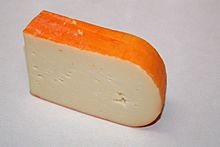Mahón cheese facts for kids
Quick facts for kids Maó |
|
|---|---|
 |
|
| Other names | Mahón, Mahón-Menorca |
| Country of origin | Spain |
| Region | Balearic Islands, Spain |
| Town | Menorca, Maó |
| Source of milk | Cows |
| Texture | Soft to hard |
| Dimensions | 20 cm × 20cm × 9 cm |
| Weight | 2–3 kg |
| Aging time | 3 weeks – 2 years or longer |
| Certification | DOP 1985 |
Maó cheese is a tasty white cheese from the island of Menorca in Spain. It is made from cow's milk and can be soft or hard. This special cheese gets its name from the town of Maó, a port on the island. Menorca is well-known for making excellent cheese and has one of Europe's best dairy farms.
Contents
History of Maó Cheese
Cheese has been a very important food in Menorca for a long time. It is made on the island using cow's milk, following old traditions. Farmers curdle the milk at a low temperature, add salt, and let the cheese age. This way of making cheese is a big part of Menorca's history and food culture.
Scientists have found old pottery on the island from around 2000 or 3000 BC. These pots might have been used by farmers to make cheese back then!
Written records from the 5th century also talk about cheese from Menorca. For example, a letter from Bishop Sever in the year 417 mentions that people in Menorca ate milk and cow's cheese.
In 1985, Maó cheese received a special award called the "Designation of Origin". This means it is a protected product from a specific area. In 1997, its name was changed to "Maó-Menorca Cheese" to include the island's name.
How Maó Cheese is Made
About a hundred years ago, a special group of people called recogedores (gatherer-ripeners) helped make Maó cheese famous. They traded farm products and in return, farmers gave them fresh cheeses.
The recogedores had special caves to store and age the cheeses carefully. They watched the weather, temperature, and how the cheese was handled. This helped them create the original Maó cheese, which could be soft, airy, or well-aged. They sold this cheese all over the islands and in Spain. Their clever methods made Maó cheese a popular product to export.
The cows in Menorca are very well cared for and produce a lot of milk, more than in many other parts of Spain. All the milk from about 600 farms on the island is used to make dairy products, including this famous cheese.
What Maó Cheese is Like
Maó cheese has a special taste and look, even as it gets older. It usually tastes buttery, a little salty, and has a nice smell that is sweet and nutty.
The sweet and sometimes salty taste of Maó cheese comes partly from the sea salt in the grass that the cows eat. The outside of the cheese, called the rind, is usually orange. This color comes from rubbing the rind with butter, oil, and paprika.
As the cheese gets older (around 10 months), it might have small, uneven holes and feel a bit grainy. All older Maó cheese tends to have many tiny holes inside.
Young Maó Cheese
Maó artesà is a young cheese, aged for less than three months. It is softer than older Maó cheese. If you have young Maó, it's best to keep it in the vegetable part of your refrigerator. Wrap it tightly in plastic to keep it soft.
Aged Maó Cheese
On the other hand, harder, older Maó cheese should be wrapped in foil or waxed paper. This helps it stay fresh and keeps its texture.
Ways to Enjoy Maó Cheese
- Maó is known as one of the most useful cheeses in Spanish cooking.
- Because it has a creamy texture, it is great to serve over pasta, potatoes, rice, or vegetable dishes.
- Traditionally, people ate Maó cheese in slices, with a little olive oil, black pepper, and tarragon sprinkled on top.
- Much of the Maó cheese made is used to create processed cheese.
See also
 In Spanish: Queso de Mahón-Menorca para niños
In Spanish: Queso de Mahón-Menorca para niños


